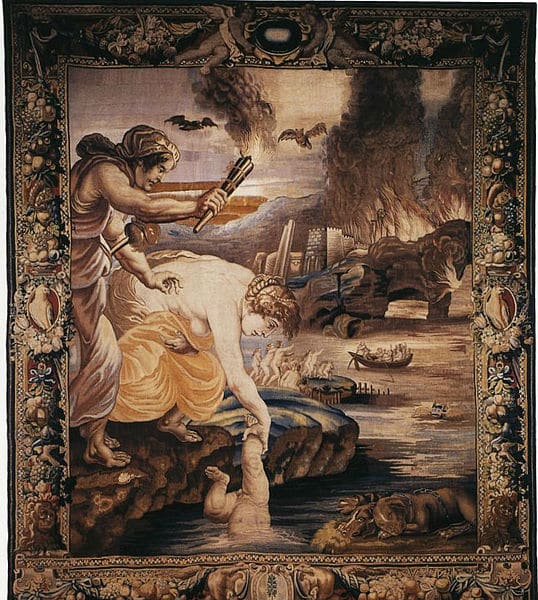Styx is the goddess whose very name sends shivers down the spine. She’s not just a river in the Underworld; she’s a deity, a force to be reckoned with. In this comprehensive guide, we’ll delve into the enigmatic goddess, exploring her origins, relationships, and the roles she played in the grand tapestry of Greek mythology.
Styx Key Facts
| Parents | Oceanus and Tethys |
| Partners | Pallas |
| Siblings | Metis, Dione, among others |
| Offspring | Zelus, Nike, Kratos, Bia |
| Roman name | Styx |
| The Goddess of | Oaths, River in the Underworld |
| Symbols | River, Jar |
Name and Etymology
Styx is a name that evokes both awe and dread. Derived from the Greek word “stygós,” it means “hatred” or “dread.” In Roman mythology, she retains her name, a testament to her universal significance. Various epithets and other names aren’t as common for Styx, perhaps due to the singular role she plays in the myths.
The name itself is a powerful symbol, representing the boundary between Earth and the Underworld. It’s the river that all souls must cross to reach Hades, the god of the underworld, the realm of the dead.
In the grand scheme of things, Styx is a unique figure. Unlike other deities who have Roman counterparts with different names (Zeus and Jupiter, for instance), Styx remains Styx. This constancy perhaps reflects her immutable nature as the ultimate boundary and oath-keeper.

Styx Origins
Born to the Titans Oceanus and Tethys, Styx was part of an illustrious family. She was one of the many Oceanids, sea Nymphs, Guardians of Nature of great beauty and power. Yet, even among her numerous siblings, Dione for one, she stood out, destined for a unique path.
During the Titanomachy, between the Titans and Olympians, she was the first to side with Zeus. Her allegiance wasn’t just symbolic; it was a game-changer, setting the stage for the Olympians’ victory.
In Greek mythology, Styx isn’t just a goddess; she’s also a Daemone, a personification of the river that serves as the boundary to the Underworld. Her dual nature adds layers of complexity to her character, making her more than just a static figure in mythological narratives.
Styx’s Family: A Tapestry of Power and Influence
When it comes to divine relationships, Styx’s life is a fascinating tale. Her partnership with Pallas, a Titan god of warcraft, wasn’t just a romantic dalliance; it was a strategic alliance that bore powerful offspring. Let’s delve deeper into this intriguing family dynamic.
Pallas: The Strategic Partner
Pallas was a Titan associated with warcraft and, in some accounts, wisdom. His union with Styx wasn’t just a meeting of hearts but also of minds and powers. Together, they formed a formidable alliance that had far-reaching implications, especially during the Titanomachy. Pallas himself was a formidable figure, but when aligned with Styx, their combined influence was magnified, creating a partnership that was both familial and strategic.
Zelus: The Embodiment of Zeal
Zelus, the first of their children, personified zeal and emulation. He was not just a divine being but a concept, a driving force that embodies the spirit of competition and rivalry. Zelus was a constant companion to Zeus, serving as a reminder of the competitive spirit that fuels excellence and ambition. His role wasn’t just to stand beside Zeus but to inspire him, to stoke the fires of his divine aspirations.
Nike: The Winged Victory
Nike, perhaps the most famous of Styx’s children, was the winged goddess of victory. She wasn’t just a symbol but an active participant in battles, tipping the scales in favor of those she favored. Often seen beside Athena, the goddess of wisdom, Nike represented the ultimate goal of any struggle: triumph. Her wings symbolized the fleeting nature of victory, urging mortals and gods alike to seize it before it flies away.
Kratos and Bia: The Dynamic Duo
Kratos and Bia were inseparable, often seen together as they carried out Zeus’s decrees. Kratos, Embodiment of Divine Strength was the embodiment of strength, representing the raw power that underpins divine authority. Bia, on the other hand, personified force, the application of strength. Together, they were the muscle behind Zeus’s rule, ensuring that his commands were executed. They were not just offspring of Styx and Pallas; they were essential cogs in the machinery of divine governance.
The Collective Influence
Styx’s family wasn’t just a collection of individual powers; it was a cohesive unit that played a significant role in the cosmic order. Each member, from Pallas to Bia, contributed to this collective influence. They were bound not just by blood but by purpose, serving as the enforcers of oaths, the arbiters of victory, and the personifications of essential cosmic principles.
Depiction And Characteristics
Styx is often depicted as a dark, shadowy figure, sometimes holding a jar from which the river flows.
Her appearance is as enigmatic as her nature. She’s often shown in dark robes, a nod to her dominion over the dread-filled river. Symbols associated with her include the river itself and sometimes a jar or urn, signifying the containment of her waters.
Styx Personality and Powers
As for her personality, Styx is solemn and severe. She’s not one for frivolities. Her role as the ultimate oath-keeper among gods and mortals alike gives her a stern demeanor. She’s revered and feared, a goddess you wouldn’t want to cross—literally and metaphorically.
When it comes to powers, Styx is unique. She doesn’t wield a weapon or control natural elements like other gods. Her power lies in her sanctity; her river is the ultimate boundary, and her name the ultimate oath. Even Zeus, the king of gods, respects the promises made upon the river Styx.
Symbols
Her primary symbols are the river and the jar, both of which encapsulate her essence. The river represents the boundary between worlds, while the jar signifies containment, a holding place for oaths and promises.
Styx Roles And Responsibilities
Styx had a unique role in the pantheon of Greek gods. She was the goddess of the river that separated the world of the living from the world of the dead. But she was more than just a boundary; she was also the goddess of oaths, a role that even Zeus took seriously.
Her river wasn’t just a geographical feature; it was a divine entity. Souls of the departed had to cross it to reach the Underworld, and Charon, The Solemn Ferryman of the Underworld, the ferryman, was the one to take them across, provided they could pay the toll.
Lastly, her children—Zelus, Nike, Kratos, and Bia—played significant roles as enforcers and companions to Zeus. In this way, Styx’s influence extended beyond her immediate domain, reaching into the very halls of Mount Olympus.
Myths about Styx
Styx is a figure who looms large in several key myths, serving as both a boundary and a bridge between worlds, both literally and metaphorically.
The Titanomachy
The Titanomachy was the epic struggle that pitted the old gods, the Titans, against the new Olympian order led by Zeus. Styx wasn’t just a spectator in this celestial conflict; she was a game-changer. When the call to arms echoed through the heavens, Styx was the first to ally herself with Zeus, bringing with her invaluable resources: her own children. Zelus, Nike, Kratos, and Bia became constant companions to Zeus, embodying zeal, victory, strength, and force, respectively.
Her waters were also used in a sacred ritual to seal the alliance among the gods. It was said that any god who broke an oath made upon the river Styx would be deprived of nectar and ambrosia for nine years, a severe punishment that even gods feared. This alliance wasn’t a mere footnote in the annals of mythology; it was a pivotal moment that tipped the scales in favor of the Olympians, leading to their ultimate victory and the imprisonment of the Titans.
The Unbreakable Oath
The power of an oath sworn upon the river Styx is a recurring theme in Greek mythology. It was considered the most sacred of all promises, binding even upon the gods. Zeus himself, the king of the gods, would swear upon Styx’s name, and the other gods followed suit. Breaking such an oath was unthinkable; the consequences were dire and involved a nine-year exile from the divine council and feasts.
This myth underscores Styx’s role as the ultimate arbiter of truth and commitment. She wasn’t just a passive river but an active force that held the gods accountable for their actions. Her role as the keeper of oaths elevated her status, making her indispensable in the divine hierarchy.
The Role in the Trojan War
Styx’s influence wasn’t confined to the realm of gods; it trickled down to mortal affairs, most notably the Trojan War. Achilles, the great Greek hero, was said to have been dipped into the river Styx by his mother, Thetis, to make him invulnerable. The waters of Styx rendered his body impervious to harm, except for his heel, which Thetis had to hold to dip him into the river.
This small oversight became Achilles’ downfall. Despite his near invincibility, he was eventually killed by an arrow to his heel, the only vulnerable part of his body. This myth not only highlights the transformative power of Styx’s waters but also serves as a cautionary tale about the limits of divine intervention in human affairs.
Styx In Ancient Greek Religion
Styx was more than just a mythological figure; she was an integral part of ancient Greek religious practices.
There are no specific temples dedicated solely to Styx, perhaps due to her grim associations. However, her presence was felt in rituals involving oaths and promises. Her name was invoked in the most solemn of vows, making her an unseen but ever-present deity in religious practices.
Oaths sworn upon her were considered the most binding, and breaking them was a grave offense, not just in the eyes of gods but also among mortals.
Representations Of Styx In Art
Styx is not as commonly depicted in ancient art as some other gods, but when she is, it’s often in the context of the Underworld. She’s usually shown as a shadowy figure, sometimes holding a jar from which her river flows, emphasizing her role as the boundary between worlds.

Mentions in Ancient Texts
In the “Theogony,” written around the 8th century BCE, Hesiod describes her as the daughter of Oceanus and Tethys and talks about her role in the Titanomachy.
One memorable quote comes from Homer’s “Iliad”: “As many as are the channels and streams of the river Styx.” This line encapsulates the complexity and multifaceted nature of Styx, portraying her as more than just a river but a network of divine pathways.
Frequently Asked Questions
Styx is the goddess of the river that serves as the boundary to the Underworld and the goddess of oaths.
She is the daughter of the Titans Oceanus and Tethys.
She has four children: Zelus, Nike, Kratos, and Bia.
Yes, her name and role remain consistent in Roman mythology.
Featured Image Credit: Joachim Patinir, Public domain, via Wikimedia Commons
